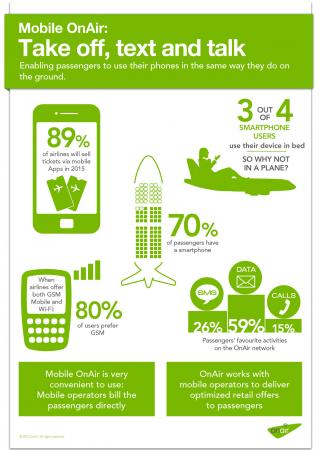Aurélie Branchereau-Giles from OnAir talks inflight Wi-Fi
OnAir?s Aurélie Branchereau-Giles tells how inflight Wi-Fi could be a game changer
 Social Media Portal (SMP): What is your name and what do you do there at OnAir?Aurélie Branchereau-Giles (ABG)
Social Media Portal (SMP): What is your name and what do you do there at OnAir?Aurélie Branchereau-Giles (ABG): I am director of PR and communications at OnAir. I am responsible for building and maintaining OnAir?s reputation as the world?s leading inflight connectivity provider.
SMP: Briefly, tell us about OnAir (for those that don?t know), what is it and what does company do?ABG:
OnAir sets the benchmark for global inflight connectivity solutions, with over 50 customers on five continents. We are the only provider to offer consistent global coverage for both inflight GSM and Wi-Fi, thanks to regulatory approvals from over 100 countries, more than 350 roaming agreements, and by using Inmarsat?s I4 satellite networks.
OnAir?s products enable passengers to use their own mobile phones, smartphones, tablets and laptops in exactly the same way as they do on the ground, either through the onboard GSM network or the onboard Wi-Fi hotspot. OnAir also provides on-demand entertainment content, such as music, videos, newspapers and magazines. The products are available as linefit or retrofit for all commercial aircraft, government, VIP and business jets and ships.
SMP: When was the company founded, by whom and how people work there?OnAir was incorporated in February 2005, founded by SITA, the leading IT solutions provider to the air transport world, and Airbus.
OnAir is headquartered in Geneva and has offices in Seattle, Dubai, Kuala Lumpur and Singapore. In total, we have around 70 employees.
SMP: How is the company funded and what are its main partnerships? ABG: SITA is now OnAir?s sole shareholder.
SITA is also one of our key partners. In particular, the two companies are working together to develop the fully connected passenger journey. Passengers are increasingly in complete control of their entire journey using their personal electronic devices, from buying the ticket, checking-in, dropping their bags, going through security ? and having access to the full range of GSM and Wi-Fi connectivity during the flight.
Inmarsat provides us with global satellite coverage. Airbus, Thales and TriaGnoSys provide our inflight systems. And DTI is our partner in the entertainment solutions we provide.
 SMP: Who are your target audience and why?ABG
SMP: Who are your target audience and why?ABG: OnAir?s main audiences are commercial airlines, and owners and operators of government, VIP and business aircraft. They are our customers and potential customers.
Other key audiences are passengers, mobile network operators ? our roaming partners, aviation and telecoms regulators, service resellers, the media and industry analysts.
SMP: You?ve recently launched OnAir Play, why is this and what does it do?ABG: For the first time, we are combining inflight connectivity with films, TV, live news, music, games, magazines and newspapers. Passengers will now have access to a full range of content including live news and sport, updated throughout the flight and can buy destination-based goods and services to ease their arrival.
OnAir Play marks the start of a new era in how we spend our time during the flight. The rationale behind it is that on the ground the way we watch TV and films or listen to music has changed to an on-demand mentality. We can even provide passengers with regularly refreshed, time-sensitive content, such as news and sport. We want to tell people about what we're doing, through social media, email, text messages and even talking to them. Why should it be different when we fly?
SMP: How long did it take to put into place and how long do you expect it to be before all airlines use it, or something similar to it?ABG: OnAir Play is an evolution of our connectivity services and is something we have been developing for some time. We expect to announce the launch customer in the coming months.
SMP: What is the cost to airlines and/or passengers in using the service, or being able to access Wi-Fi for flights?ABG: It is important to remember that OnAir provides both Wi-Fi (Internet OnAir) and GSM (Mobile OnAir).
Each airline has a different model and a different pricing strategy for inflight Wi-Fi. For example, some choose to provide it free for first class and business passengers. Others charge passengers based on time, others based on usage levels.
Using the GSM network costs the same as international roaming, and works in the same way. Passengers simply turn on their phones do what they do the ground. There?s no messing about with credit cards, and you can email, surf the Internet, use SMS and make calls. Consequently, when both Wi-Fi and GSM services are available, over 80% of passengers using connectivity choose GSM.
SMP: What are the low moments of what you have been doing so far (and in regards to OnAir)?
ABG: OnAir has been at the forefront of developing entirely new services in a very challenging environment. We are providing connectivity at 11,000 meters and 850kph.
The technology itself is derived from the technology used on the ground, adapted for aviation. It has to be able to withstand the unique pressure of flying, as well as meet the stringent safety requirements. We have also needed to develop global networks of authorizations from national telecommunications regulators and roaming agreements with mobile network operators around the world. The realization of the scale of the regulatory work was an interesting moment in our development, however we have worked very hard over several years to ensure we have our unique global networks, so we can provide consistent global coverage.
SMP: What do you see as your biggest challenges and opportunities in creating content for flights?ABG: OnAir connectivity services are branded by each airline, so the content is the airlines. We support the airline in tailoring it to best suit their passengers? requirements.
SMP: What?s the next big step for your technology, what other implications / applications does it have and impact may this have upon brands?ABG: Our services are constantly evolving. There will be a major step-change when GX Aviation, Inmarsat?s global Ka-band network, comes on stream in early 2015. It will provide more capacity and bandwidth, enabling more services for both passengers and crew.
Importantly, we are rapidly moving towards the connected aircraft, which will enable connectivity applications for passengers, the cabin crew and the cockpit. Airlines and airports run highly automated, complex IT systems. However, the interface between the crew and the ground relies heavily on paper. That is outdated, slow, inefficient and expensive. We help airlines use their IT better, using the connectivity pipe to make operations much more efficient.
An aircraft?s connectivity can be used for a wide range of applications from a wide range of providers. The key point is to provide real value for the airline.
The connected aircraft builds on the communications applications already available to bring mobility to the entire passenger journey. Passengers can now do everything using their mobile devices, including book tickets, communicate with the airline. check-in, receive updates about their flight status, change onward bookings and so on. They will also be able to use the Wi-Fi network to access movies, music, newspapers and magazines, and an increasing range of other content.
Think of what can be done by transmitting information during the flight. Cabin crew can operate in a paperless environment. Any cabin information can be sent before the plane lands, to prepare the ground crew, providing an immediate saving in turnaround times by reducing the admin process once the plane has landed
Connectivity can be used to enhance customer service. Some airlines already equip cabin crew with tablets containing passenger information. These can use the connectivity to provide an even better service, for example in changing bookings on connecting flights if there is a delay.
The maintenance crew can be on-hand with the right tools and equipment to fix a problem that had been reported during the flight. Inflight connectivity can be used for aircraft health monitoring: each piece of equipment on the aircraft can be monitored and be programmed to send data automatically. The coffee machine can report when its supplies need replenishing; the sceptic tank can report when it needs emptying. It is exactly what is happening on the ground with machine-to-machine communications. These reports can be automated to remove the need for human intervention, making significant efficiency savings
Non-flight-critical data, such as weather maps, can be updated during the flight to make the aircraft operations more efficient. Likewise, Electronic Flight Bags could be updated during the flight, saving the cockpit crew?s time on the ground.
 SMP: With Wi-Fi being enabled for flight, what sort of issues can you see for airlines (what are the positives and potential drawbacks)?ABG
SMP: With Wi-Fi being enabled for flight, what sort of issues can you see for airlines (what are the positives and potential drawbacks)?ABG: Again, it is important to remember that OnAir provides both Wi-Fi (Internet OnAir) and GSM (Mobile OnAir).
The biggest positive is that people can use their phones, tablets and laptops during the flight in exactly the same way as they do on the ground. There is an expectation that we can be connected at all times. Flying is no different.
Think of how you use your phone. For most people, the phone is one app among many ? email, SMS, social media, Internet, camera, news, music, videos, games, books, newspapers and so on. This is reflected in inflight usage. Just under half of passengers using the GSM network use email; another 45% use SMS and only around 10% of usage is for calls.
The widely-anticipated issues arising from mobile phone usages simply have not arisen: we are not aware of any complaints to airlines in the six years that Mobile OnAir has been in operation on airlines around the world.
SMP: What is the most challenging part of building upon the brands presence (for on in digital environments (including social media)?ABG: OnAir is a business to business to consumer brand. It is one step away from the passenger. We have therefore consciously not sought to build a strong consumer-facing brand, though we have built a very strong reputation among airlines and business jet owners and operators.
Because the airline touches the customer, not OnAir, the key challenge is that our brand is heavily associated with our customers?.
SMP: Best way to contact you and OnAir?LinkedInYouTubeFlickrNow some questions for fun
SMP: What did you have for breakfast / lunch?ABG: I?m French: a croissant.
SMP: What?s the last good thing that you did for someone?ABG: I coached a junior colleague who was swamped under loads of deadlines.
SMP: If you weren?t working at OnAir what would you be doing?ABG: I would be an architect.
SMP: When and where did you go on your last holiday (and were you able to use Wi-Fi on your flight)?ABG: We went to Brittany ? by car!
SMP: Where is one place you wouldn?t use Wi-Fi and why?
ABG: In the bath, as I would probably drop my phone and kill it!
SMP: What?s the first thing you do when you get into the office of a morning?ABG: I check email before I leave home and plan my day in the car. In the office, I always start with a cup of coffee and turning on my computer. Thereafter, each day is different.
SMP: If you had a superpower what would it be and why?ABG: I would like to be able to teleport, so I could create more time in the day.
If you're interested in doing a Social Media Portal (SMP) interview, get in touch.
